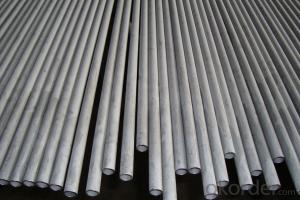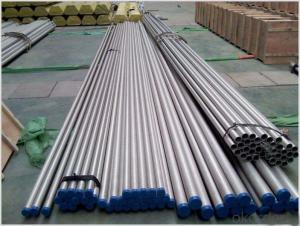Boiler Heat Exchange Stainless Steel Pipe 31803 ASTM A213
- Loading Port:
- Ningbo
- Payment Terms:
- TT OR LC
- Min Order Qty:
- 1 m.t.
- Supply Capability:
- 5000 m.t./month
OKorder Service Pledge
OKorder Financial Service
You Might Also Like
1、Structure of Boiler Heat Exchange Stainless Steel Pipe 31803 ASTM A213 Description:
Boiler Heat Exchange stainless steel pipe is often used in the heating system. Heating system, or those stored energy (such as solar energy) in the form of heat, need to be built with the material that can withstand temperatures up to 550 degrees Celsius. High chromium molybdenum welded steel pipe can work in the extreme, which maintain as the ideal material for the construction of power station.
2、Main Features of Boiler Heat Exchange Stainless Steel Pipe 31803 ASTM A213:
• High manufacturing accuracy
• High strength
• Small inertia resistance
• Strong heat dissipation ability
• Good visual effect
•Reasonable price
3、Boiler Heat Exchange Stainless Steel Pipe 31803 ASTM A213 Images:
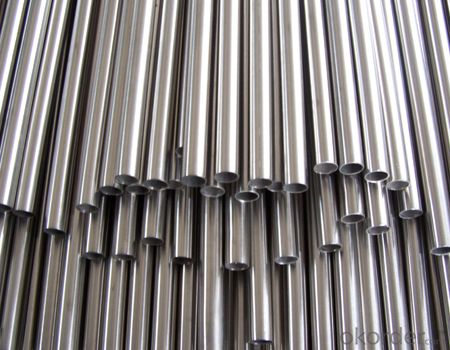
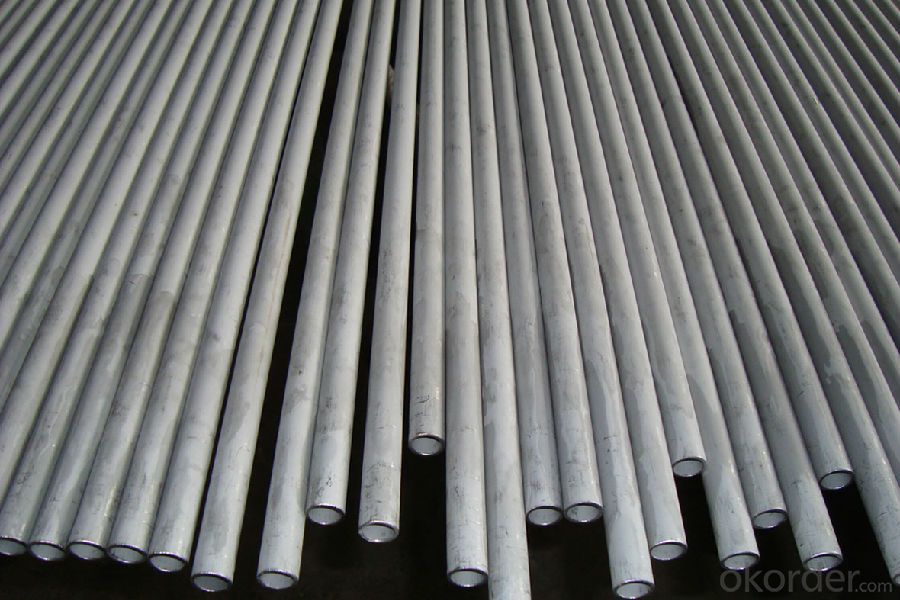
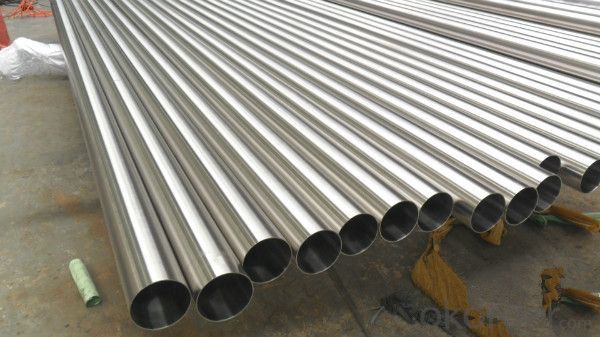
4、Boiler Heat Exchange Stainless Steel Pipe 31803 ASTM A213 Specification:
1)Commodity: heat exchanger pipe
2))Material: 304,316L,304L,316,321,310S,etc
3)Thickness:0.5-100mm
4)Length: 1-14m
| Material Grade | 304,304L,316 ,316L,321,310S,2205,904and so on. |
| Standard | ASTM A312, A554, A249, A269 and A270,ect |
| DIN 17456-85 , DIN 17458-85, DIN 17459-92,ect | |
| JIS G3446-1994, JIS G3448-1997, JIS G3459-1997, JIS G3463-1994,ect | |
| GB13296-1991, GB14975-2002, GB14976-2002,ect | |
| Outer Diameter | 13.7-2020mm |
| Thickness | 0.5-50mm |
| Length | 1m -12m or as customers' request |
| Polish | 180G, 320G, 400G Satin / Hairline |
| 400G, 500G, 600G or 800G Mirror finish | |
| Test | eddy current inspection, ultrasonic inspection, X-ray inspection, real-time imaging, hydrostatic test, spectral analysis, intergranular corrosion, water pressure test, and mechanical property testing facilities. |
| Payment | 1) by L/C at sight, |
| 2) 30% deposit, 70% balance before Shipping. | |
| Delivery time | A.7 days if this goods is stock goods. |
| B.25 days if this goods will be produced after order | |
| Validity | Valid time is 3 days for price usually. |
| Payment terms | FOB QINGDAO |
| MOQ | 1 ton |
| Capacity | 1000 ton per month |
| Certificate | ISO, SGS, and third part inspection |
| Applications | the products are widely used in chemical industry, condenser pipe, heat exchanger, petroleum, shipping military, environment protection, high temperature resistant, low temperature resistant, corrosion resistant and so on. |
| packing details | 1) Wooden-box Package. 2) The Wooden Frame Packing. 3) Intertexture Cloth Packaging with the Iron Sheet Bonding and the Two Terminals Covered With Plastic Dome. |
5、FAQ of Boiler Heat Exchange Stainless Steel Pipe 31803 ASTM A213:
①How is the quality of your products?
Our products are manufactured strictly according to national and internaional standard, and we take a test on every pipe before delivered out. If you want see our quality certifications and all kinds of testing report, please just ask us for it.
Guaranteed: If products’ quality don’t accord to discription as we give or the promise before you place order, we promise 100% refund.
②How about price?
Yes, we are factory and be able to give you lowest price below market one, and we have a policy that “ for saving time and absolutely honest business attitude, we quote as lowest as possible for any customer, and discount can be given according to quantity”,if you like bargain and factory price is not low enough as you think, just don’t waste your time.Please trust the quotation we would give you, it is professional one.
③Why should you chose us?
Chose happens because of quality, then price, We can give you both.Additionally, we can also offer professional products inquiry, products knowledge train(for agents), smooth goods delivery, exellent customer solution proposals.Our service formula: good quality+good price+good service=customer’s trust
SGS test is available, customer inspection before shipping is welcome, third party inspection is no problem.
Any question, pls feel free to contact us !
- Q:Can stainless steel pipes be used for solar power systems?
- Indeed, stainless steel pipes possess the capability to be utilized in solar power systems. Owing to its remarkable endurance and resistance to corrosion, stainless steel emerges as a fitting selection for components within solar power systems. When it comes to solar thermal systems that convert sunlight into heat energy, stainless steel pipes proficiently handle the rigorous demands of high temperatures and pressure. Besides, stainless steel pipes are frequently employed in photovoltaic (PV) systems, which convert sunlight directly into electricity. These pipes serve the purpose of mounting PV panels and offering structural reinforcement. In summary, stainless steel pipes prove to be a dependable and enduring alternative for solar power systems.
- Q:Does stainless steel pipe belong to hardware?
- Hardware refers to gold, silver, copper, iron, tin, five kinds of metal materials, carbon steel and stainless steel is iron upgrade, naturally belongs to the hardware.
- Q:How do you calculate the expansion and contraction of stainless steel pipes?
- In order to determine the expansion and contraction of stainless steel pipes, one must consider the coefficient of thermal expansion specific to the grade of stainless steel being utilized. This coefficient measures the extent to which a material expands or contracts in response to temperature fluctuations. To begin, ascertain the initial length of the stainless steel pipe, typically measured at room temperature. Subsequently, determine the temperature variation to which the pipe will be exposed. This variation is determined by calculating the difference between the maximum and minimum temperatures the pipe will encounter. Following this, multiply the initial length of the pipe by the coefficient of thermal expansion corresponding to the specific grade of stainless steel employed. Since the coefficient of thermal expansion can differ depending on the alloy and composition of the stainless steel, it is important to consult the manufacturer's specifications or engineering references for the specific grade in use. Lastly, multiply the obtained result by the temperature variation to ascertain the expansion or contraction of the stainless steel pipe. A positive value indicates expansion, while a negative value indicates contraction. It is crucial to note that the calculated expansion or contraction of the stainless steel pipe is an approximate value and can vary due to factors such as the specific alloy composition, manufacturing processes, and installation conditions. As such, it is advisable to consult a qualified engineer or refer to industry standards for more accurate calculations in specific applications.
- Q:What are the limitations of using stainless steel pipes?
- The utilization of stainless steel pipes is associated with several limitations. To begin with, stainless steel pipes are inclined to be pricier in comparison to materials like PVC or copper. This aspect can render them less viable for projects with financial constraints. Moreover, the installation of stainless steel pipes can be more challenging and necessitate the use of specialized tools and equipment. Consequently, this can lead to an increase in both the overall installation time and cost. Another constraint is that stainless steel pipes are unsuitable for the transportation of certain corrosive chemicals or gases. There is a possibility of a chemical reaction occurring with certain substances, resulting in corrosion and potential harm to the pipes. In such scenarios, alternative materials such as plastic or lined pipes may be more suitable. Additionally, stainless steel pipes may possess limitations in terms of their resistance to temperature and pressure. Although they can withstand relatively high temperatures and pressures, extreme conditions may require the utilization of more robust materials. Furthermore, stainless steel pipes exhibit lower thermal conductivity compared to other materials, implying that they are not as efficient in transferring heat. This can be a limitation in certain heating or cooling applications that require rapid heat transfer. Lastly, stainless steel pipes are susceptible to expansion and contraction with changes in temperature. Consequently, the use of expansion joints or other measures may be necessary to accommodate these movements and avoid potential damage. In conclusion, although stainless steel pipes offer numerous advantages such as durability and resistance to corrosion, it is crucial to carefully consider their limitations before selecting them for a specific project.
- Q:How do you prevent condensation in stainless steel pipes?
- To prevent condensation in stainless steel pipes, there are several measures you can take: 1. Insulation: Apply insulation materials, such as foam or fiberglass, around the pipes. This will help maintain the temperature inside the pipe, preventing the outer surface from becoming cold and reducing the likelihood of condensation. 2. Vapor barriers: Install vapor barriers around the pipes to prevent moisture from reaching the pipe surface and causing condensation. These barriers can be made of materials like plastic or aluminum foil and should be properly sealed to ensure their effectiveness. 3. Increase pipe temperature: If possible, increase the temperature of the fluid or gas flowing through the pipes. This can be achieved by adjusting the temperature of the heat source or utilizing heat tracing systems that provide a constant heat supply to the pipe. 4. Proper ventilation: Ensure there is adequate airflow around the pipes, especially in areas where condensation is more likely to occur. This helps to dissipate any moisture that may accumulate and reduce the chances of condensation. 5. Reduce humidity: In areas with high humidity, consider implementing dehumidification methods, such as using dehumidifiers or installing moisture-absorbing materials, to lower the overall moisture content in the air. This can help minimize the potential for condensation. By implementing these preventive measures, you can significantly reduce the risk of condensation in stainless steel pipes, thereby protecting them from potential corrosion and maintaining their overall performance and longevity.
- Q:Are stainless steel pipes suitable for underground water supply?
- Indeed, stainless steel pipes are a fitting choice for underground water supply. With its exceptional resistance to corrosion and rust, stainless steel proves to be an optimal material for underground usage, where pipes may confront moisture, soil, and other corrosive substances. Notably, stainless steel pipes exhibit durability, longevity, and possess a remarkable tensile strength, enabling them to endure the pressure and strain of underground installations. Furthermore, stainless steel pipes maintain hygiene and do not release detrimental chemicals or pollutants into the water supply. All in all, stainless steel pipes present a dependable and secure alternative for underground water supply systems.
- Q:Can stainless steel pipes be wrapped with tape?
- Yes, stainless steel pipes can be wrapped with tape. However, it is important to use the appropriate type of tape designed specifically for stainless steel. This is because stainless steel pipes are often used in industrial and high-temperature applications, and ordinary tapes may not be able to withstand the extreme conditions. Stainless steel pipe tapes are typically made of materials like stainless steel foil or aluminum foil with a heat-resistant adhesive to ensure long-lasting durability and resistance to corrosion. These tapes can be used for various purposes such as insulation, sealing, or protection against abrasion. It is always recommended to consult the manufacturer's guidelines or seek professional advice before applying any tape to stainless steel pipes to ensure proper installation and avoid any potential issues.
- Q:Where is the difference between seamless steel pipe and welded pipe?
- 1., the appearance of seamless steel pipe and welded pipe difference in the welded pipe wall welded tendons, and seamless No.2. seamless pipe pressure is higher, welded pipe is generally in 10 or so MPa, now welded pipe to do seamless processing.3. seamless steel tube is formed in the rolling process. Welded steel pipes need to be welded after coiling, and spiral welding and direct welding are generally used. Seamless performance is better, of course, the price is higher.
- Q:How do you prevent vibration in stainless steel pipes?
- To prevent vibration in stainless steel pipes, various measures can be taken: 1. Employ suitable pipe supports: It is imperative to carefully select and install appropriate pipe supports. These supports should be designed to offer ample stability and rigidity to the pipe system, minimizing any potential movement or vibration. 2. Mitigate vibrations with isolators: Strategic placement of vibration isolators along the pipe system can help absorb and dampen vibrations. This reduces the transmission of vibrations through the stainless steel pipes. 3. Ensure proper pipe alignment: During installation, ensure that the pipes are aligned correctly. Misalignment can lead to stress concentrations and heightened vibration. Proper alignment helps distribute forces evenly and reduces vibration. 4. Decrease fluid velocity: High fluid velocities can induce turbulence and vibrations in the pipe system. By reducing the fluid velocity, either through adjusting the flow rate or utilizing flow control devices like throttling valves, vibrations can be minimized. 5. Implement soundproofing measures: In certain cases, vibrations may be caused by external factors, such as nearby machinery or equipment. To reduce noise and vibrations originating from these sources, consider implementing soundproofing measures like using noise-absorbing materials or installing vibration-blocking barriers. 6. Regularly maintain and inspect the pipe system: Conduct routine inspections to detect any signs of vibration or wear in the pipe system. Address any issues promptly to prevent further vibration problems. Additionally, ensure proper maintenance of the pipe system, including regular cleaning and lubrication of any moving parts. By implementing these measures, vibration in stainless steel pipes can be effectively prevented, ensuring the overall stability and integrity of the pipe system.
- Q:Can stainless steel pipes be used for geothermal applications?
- Indeed, geothermal applications can make use of stainless steel pipes. Stainless steel is renowned for its durability and resistance to corrosion, enabling it to withstand the challenging conditions and elevated temperatures commonly found in geothermal systems. Its exceptional resistance to corrosion caused by minerals and chemicals present in the geothermal fluid makes it particularly well-suited for such applications. Moreover, stainless steel pipes exhibit outstanding heat transfer properties, crucial for efficient heat exchange within geothermal systems. Furthermore, these pipes boast an extended lifespan and demand minimal maintenance, rendering them a dependable option for geothermal applications.
1. Manufacturer Overview |
|
|---|---|
| Location | |
| Year Established | |
| Annual Output Value | |
| Main Markets | |
| Company Certifications | |
2. Manufacturer Certificates |
|
|---|---|
| a) Certification Name | |
| Range | |
| Reference | |
| Validity Period | |
3. Manufacturer Capability |
|
|---|---|
| a)Trade Capacity | |
| Nearest Port | |
| Export Percentage | |
| No.of Employees in Trade Department | |
| Language Spoken: | |
| b)Factory Information | |
| Factory Size: | |
| No. of Production Lines | |
| Contract Manufacturing | |
| Product Price Range | |
Send your message to us
Boiler Heat Exchange Stainless Steel Pipe 31803 ASTM A213
- Loading Port:
- Ningbo
- Payment Terms:
- TT OR LC
- Min Order Qty:
- 1 m.t.
- Supply Capability:
- 5000 m.t./month
OKorder Service Pledge
OKorder Financial Service
Similar products
New products
Hot products
Hot Searches
Related keywords

